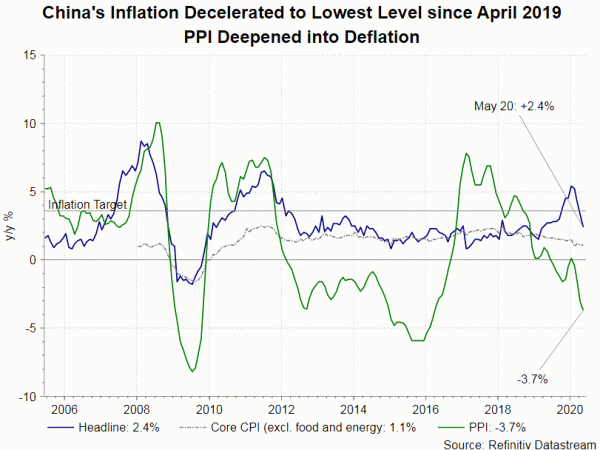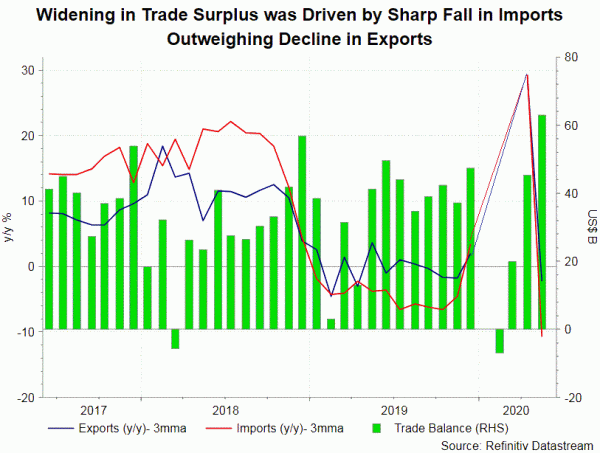Headline CPI slowed further to +2.4% y/y in May, from +3.3% a month ago. The market had anticipated a milder drop to +2.7%. The reading is the lowest since April 2019 and the first time below +3% since August 2019. Food inflation continued to ease significantly. Specifically, growth in pork price decelerated to +81.7% y/y, from +96.9% in April. Fresh vegetable price contracted -8.5% y/y in May, compared with -3.7% in the prior month, while fruit price plunged -19.3% y/y, following a -10.5% decline in April. Fuel price slumped -22% y/y in May, exacerbating from -20.5% a month ago. Excluding volatile items (food and energy prices), core CPI steadied at +1.1%. Concerning upstream prices, PPI deflation worsened to -3.7% y/y in May, from -3.1% a month ago. While this was mainly driven by the sharp fall in petroleum product price, the coal mining industry also suffered due to shrinking demand.
Concerning upstream prices, PPI deflation worsened to -3.7% y/y in May, from -3.1% a month ago. While this was mainly driven by the sharp fall in petroleum product price, the coal mining industry also suffered due to shrinking demand.
In a separate report released earlier this week, trade surplus in China surprisingly widened to US$62.9B in May, from US$ 45.3B a month ago. Despite the strong headline reading, the surplus was mainly driven by a material fall in imports. Imports contracted -16.7% y/y, after a -14.2% decline in April. The market had anticipated a -9.7% drop. Concerning China’s imports of major commodities, crude oil slumped -55.1% y/y in May, worsening form -49.3% in April. Meanwhile, imports of iron ore fell -2%, after a +18.2% increase in April. Imports of copper slipped -0.4% y/y in May (vs. -5.2% in April). Shrinking demand for commodities explains why PPI deflation has worsened in May.
Exports slipped -3.3% y/y, compared with -3.5% in April. The market had anticipated a -7% contraction for the month. Geographically, exports to the US slipped -1.2% y/y in May, after gaining +2.2% a month ago. Shipment to EU dropped -0.7% y/y, compared with -4.5% in April. Exports to ASEAN contrated-5.7% y/y, following expansion over the past two months. Exports to Japan grew -11.2% y/y. This, however, marks deceleration from a +33% growth in April.
In short, the trade report demonstrated that both domestic and global demand remained fragile in May. The worst is over, as the coronavirus pandemic appears to be under control and major economies have started to loosen restrictive measures. However, the path of recovery remains fragile. China, like other major economies, would have to maintain expansionary monetary and fiscal measures in the years ahead.














